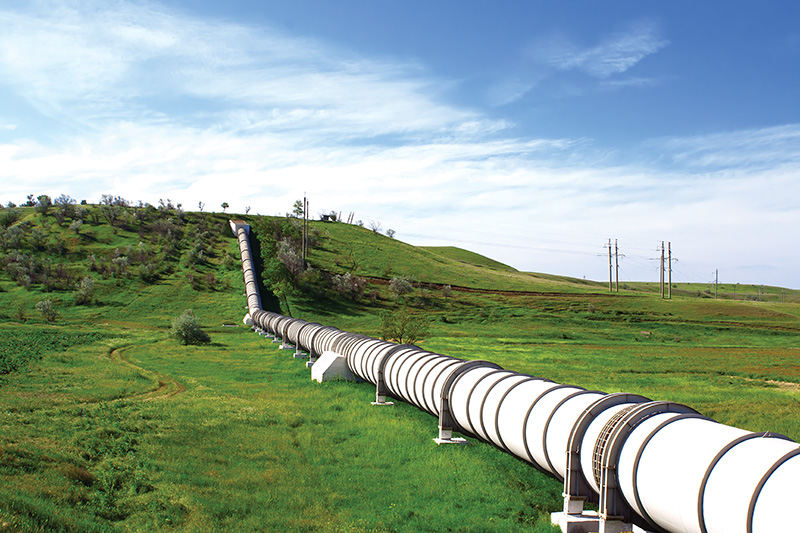March 2022, Vol. 249, No. 3
Features
Zambia’s Options in Growing Pipeline Market

By Shem Oirere, Contributing Editor
Zambia’s national demand for petroleum products is projected to surge to more than 4.4 million tons (4 million metric tonnes) by 2030, exerting pressure on the landlocked southern Africa country to explore alternatives in fast-tracking the implementation of its medium- and long-term pipeline development plan.
Currently, Zambia, Africa’s second-largest producer of copper, transports petroleum products by the underperforming and aging 1,063-mile (1,710-km) Tanzania Zambia Mafuta (Tazama) oil pipeline, and it is the sole conveyor of crude to the equally constrained Indeni oil refinery located in Ndola.
A report by the country’s Parliamentary Committee on Energy, Water Development and Tourism in June 2020 said Zambia’s national demand for the petroleum products has surged to between 1.2 mtpa and 1.3 mtpa.
Despite the increase in demand, the Committee, chaired by Ephraim Kaang’andu Belemu said, “The biggest challenge is that the oil pipeline is old and is not operating at its optimal capacity.”
“The pipeline, therefore, is in urgent need of an upgrade and rehabilitation,” the report recommends.
Previous reports indicate the pipeline is more than 40 years old, despite its design lifespan being 25 years. Its welded joints are externally coated, random lengths and circumferentially butt-welded.
At the time of the release of the Parliamentary report on the pipeline, which extends from Tanzania’s port capital of Dar es Salaam to the city of Ndola in Zambia, 28 pumping units had been delivered by Mantrac Group, a subsidiary of the internationally recognized Mansour Group. The delivery will boost the seven pumping stations to pump up to 704 gallons per minute (160 cubic meters/hour).
“The control room needed to be upgraded for accurate monitoring and actionable data over the entire pipeline to boost overall crude oil flow from Dar Es Salaam in Tanzania,” Mantrac said in a brief.
The entire Mantrac power ecosystem involves 16 Cat 3508 engines and spare parts from the United States, 16 Voith gearboxes and flexible coupling from Germany, 16 Monskid and control panels from Egypt, four fuel separators from Poland, 16 remote radiators from the UK, and a new shed partially assembled in Antwerp.
The pipeline’s capacity has been reduced from 1.1 mtpa to 750,000 tons annually, largely because of aging and corrosion. The pipeline, which is operated by Tazama Petroleum Products Ltd., a jointly owned entity by Tanzania and Zambia, has an 8-inch diameter and spans 587 miles (954 km) in Tanzania with a 12-inch diameter running 496 miles (798 km) in Zambia.
The push for the upgrade and rehabilitation of the Tazama pipeline came soon after another study by Channoil Consortium, comprising Channoil Consulting Ltd., PwC and Corpus Legal Practitioners. The study recommends the decommissioning of Tazama pipeline, which is 67% and 33% owned by Zambia and Tanzania, respectively. The study recommends a new petroleum products pipeline and the mothballing of Indeni crude oil refinery, using spare parts to construct a petroleum-receiving terminal.
The initial design for the 1965-constructed pipeline was to transport refined products such as petrol, diesel and kerosene from Kigamboni in Dar-es-Salaam to the storage terminal in Ndola, before it started delivering comingled feedstock to the Indeni refinery for processing.
“Replacement of the crude pipeline with a new 12-inch product pipeline and the mothballing of the existing refinery is the most economically advantageous option with a forecast saving of $2.3 billion and $1.3 billion over the forecast period (2030),” the Consortium reported.
“Continued maintenance of the pipeline is not considered to be a sustainable option going forward, given the existing levels of corrosion and increase in throughput required to meet current and projected demand,” it said.
In fact, the Consortium’s take is that “maintenance and repair costs on the pipeline will increase at a rate requiring significant funding, eventually outreaching new pipeline costs.”
Channoil Consortium estimates replacing the aging pipeline with a new one, constructed using the Zap-Lok system, which would lead to “significant savings in construction time, manpower and cost.”
Zambia, which imports a large share of its petroleum products from the Gulf region, usually has the products delivered to Dar-es Salaam in Tanzania by ship before they are offloaded into the Tazama tank farm at Kigamboni located at the port.
Although Tanzania and Zambia, through Tazama Petroleum Products Ltd., are still considering the option of upgrading and rehabilitating the aging Tazama pipeline, Zambia appears open to explore other avenues to meet its growing demand of petroleum products.
“Notably, the two projects that have reached advanced discussions are the Tanzania/Zambia Finished Petroleum Pipeline and the Angola/Zambia Refined Petroleum Multi-Product and Natural Gas Pipeline (AZOP),” said Matthew Nkhuwa, Zambia’s Energy Minister in a recent statement to Parliament.
Zambia and Angola have recently signed an intergovernmental memorandum of understanding (MoU) that paves way for private entities to construct and operate the $5 billion AZOP project.
Zambian-incorporated Basali Ba Liseli Resources Limited (BBLR) has been picked as the lead in an independent feasibility study that is expected to end with project bankability and financial closure by the end of 2024, according to a brief by the company.
It said the project would, when fully complete, transport an estimated 100,000 bpd of refined products “from the West Coast on the Atlantic Ocean to the main outlet terminal in Lusaka.”
“BBLR and its partners will pick the final route or routes for the full implementation of the project based on the techno-economic report and general and geo-political risk profile reports at the conclusion of the independent pre-feasibility study,” the company says on its website.
“Construction is planned to commence early 2025, upon attaining bankability and financial closure, and while operations will be commissioned in phases as the project construction progresses, full operations will be commissioned by the middle of 2027 when the oil products pipeline would have reached the main outlet terminal at Lusaka, Zambia,” BBLR added.
“The pipeline system shall include single-point moorings, gas receiving terminals, inlet tank facilities, hubs, pump stations, a main terminal, and combined cycle gas turbine plants, as well as a fibre-optic cable system,” added Minister Nkhuwa in April 2021, when the MoU was signed.
Meanwhile, Zambia is yet to arrive at a final decision on what to do with the Indeni refinery that for long has been receiving imports of high-octane petrol for blending purposes, although the Channoil Consortium report says the facility is operating “within constraints of an older straight run spiked crude refinery where demand and profile has changed significantly over the years.”
“With higher growth in demand for gasol and petrol, crude oil imports have had to be heavily spiked to include greater than 50% of lighter fractions of naphtha (15-20%) and gasol (35-55%) and throughput is currently limited by Tazama pipeline constraints,” it added.
Zambia’s consumption of petroleum products is expected to continue and could more than double current consumption in the next eight years. This could mean expansion of the country’s pipeline market as interest grows, both by public and private agencies, on the development of more new infrastructure for the transportation and storage of refined petroleum products.
Oil Majors OK on $10 Billion Tanzania, Uganda Project
(P&GJ) – Chinese and French oil giants finally sealed a $10 billion deal in early February to build a regional oil pipeline and megaproject to tap into Uganda’s energy resources.
The final investment decision (FID) is expected to pave the way for millions of barrels of oil to be shipped, and it represents the go-ahead needed to make the often-delayed project a reality.
The project will involve extraction from 100-miles (160-km) under Lake Albert, which borders Uganda and the Democratic Republic of Congo.
The deal was announced at a ceremony in Kampala, Uganda, by officials from France’s Total Energies and the China National Offshore Oil Corporation (CNOOC).






Comments